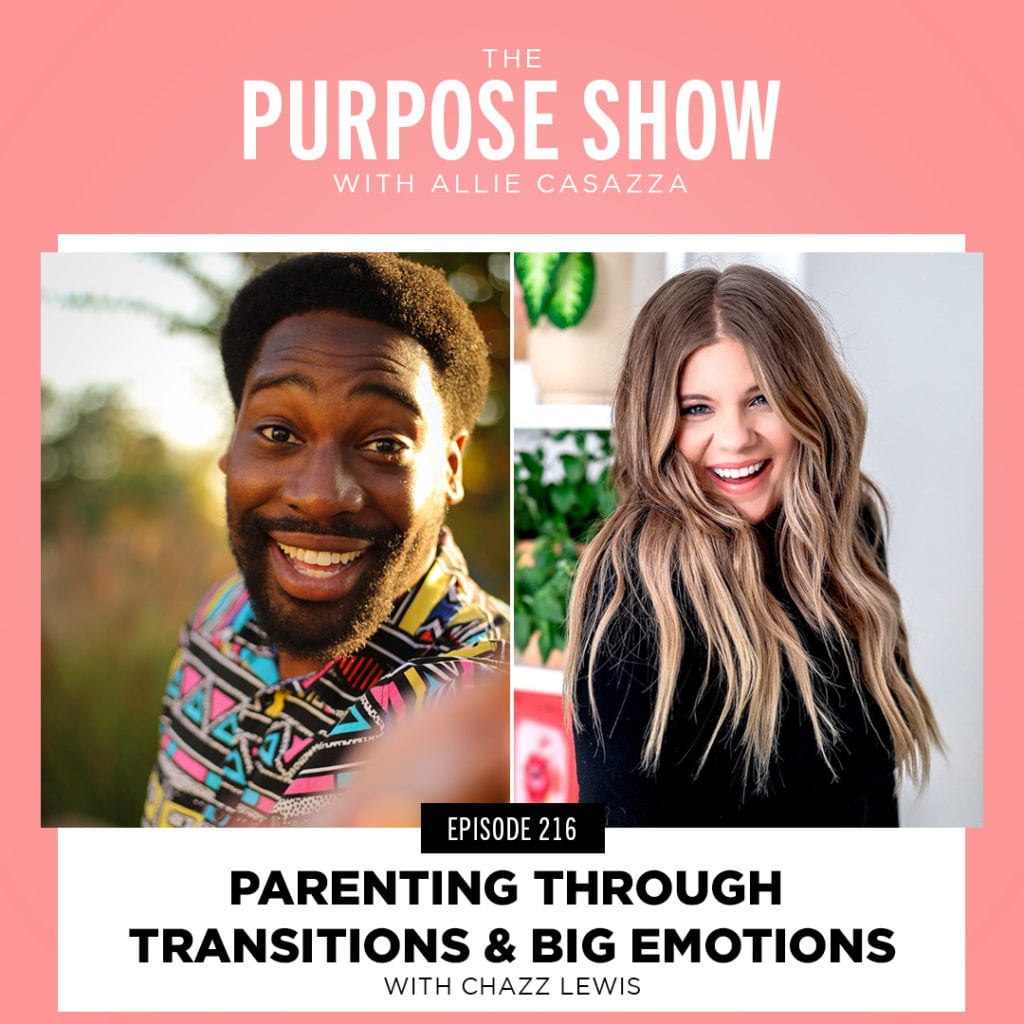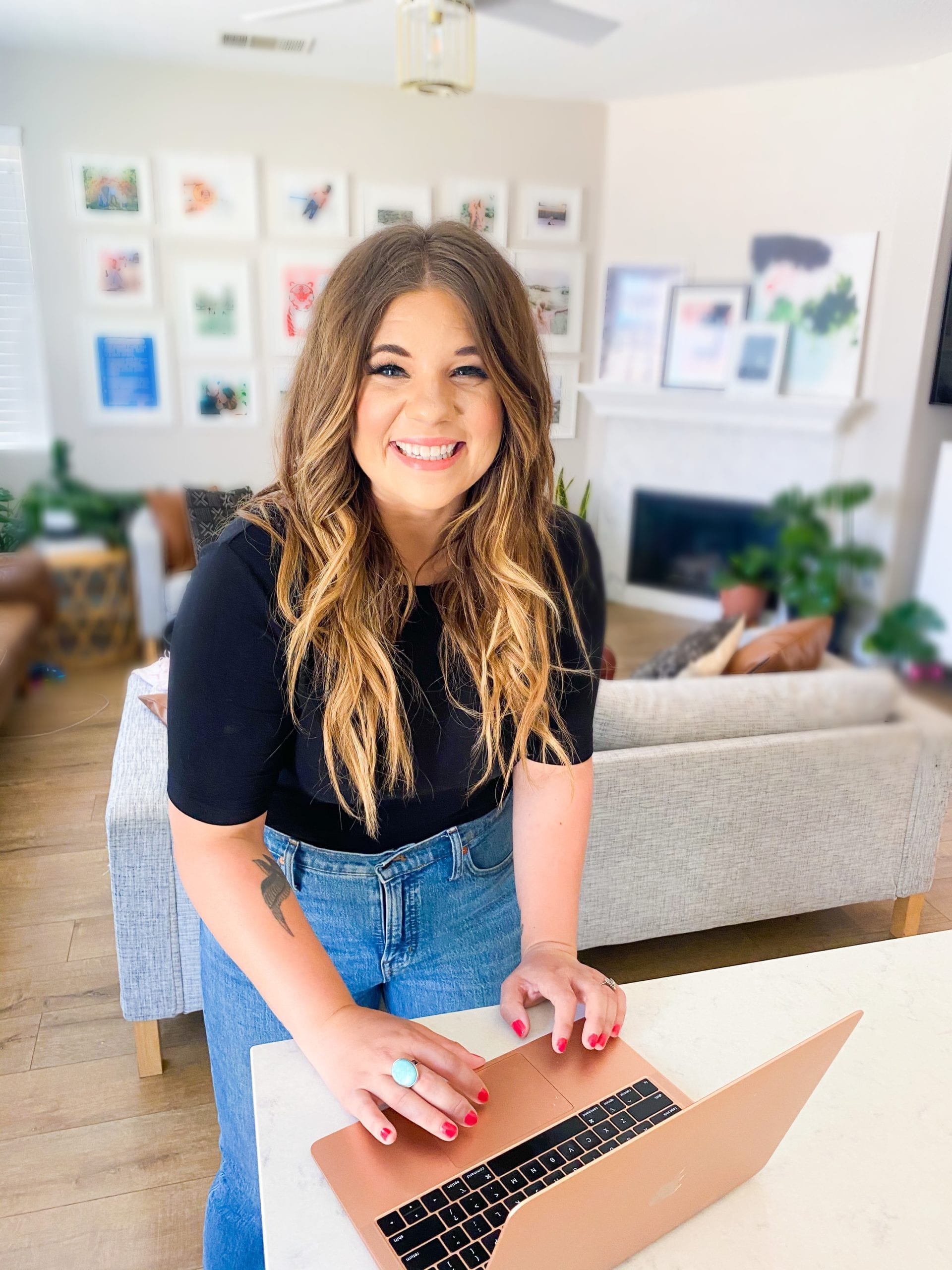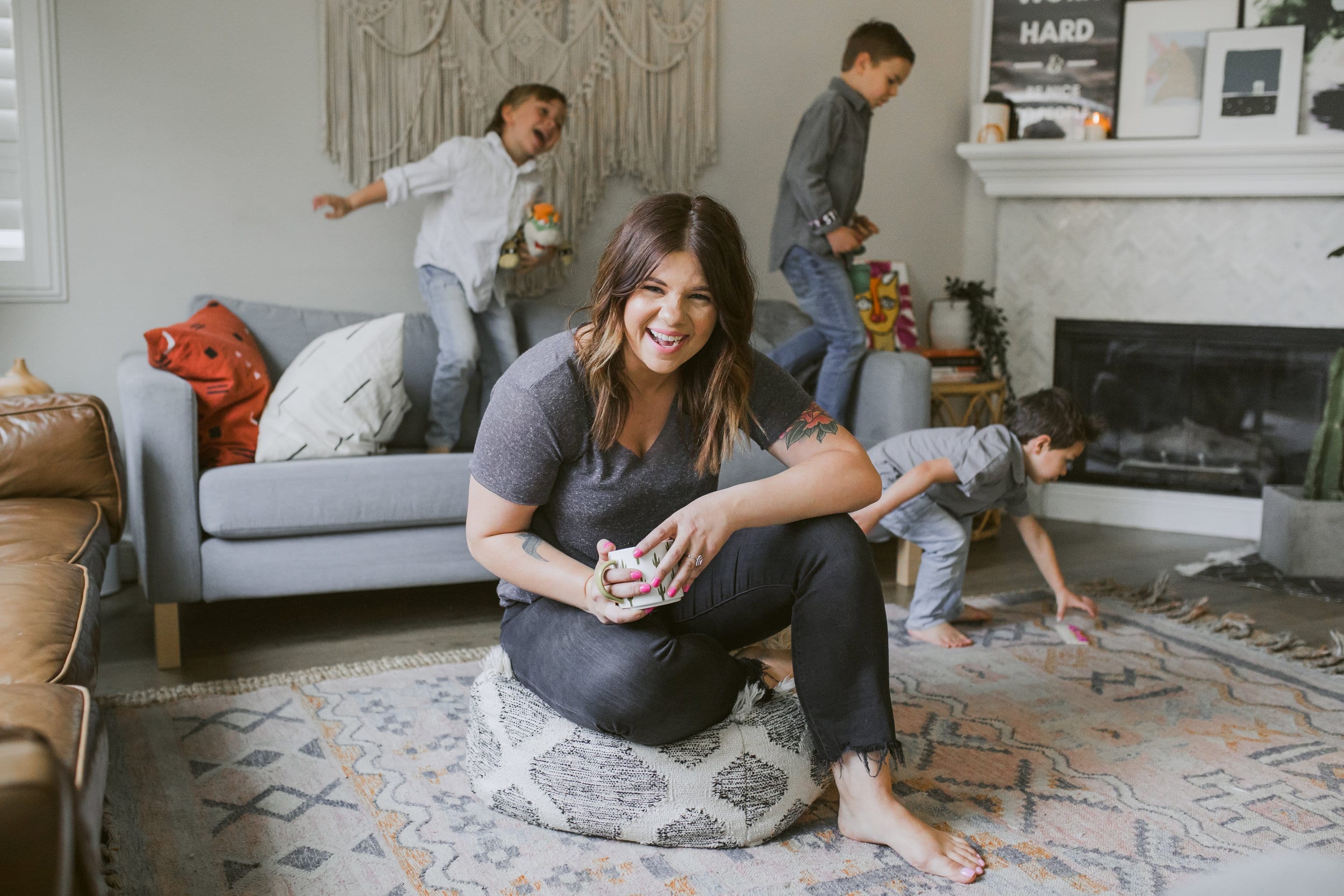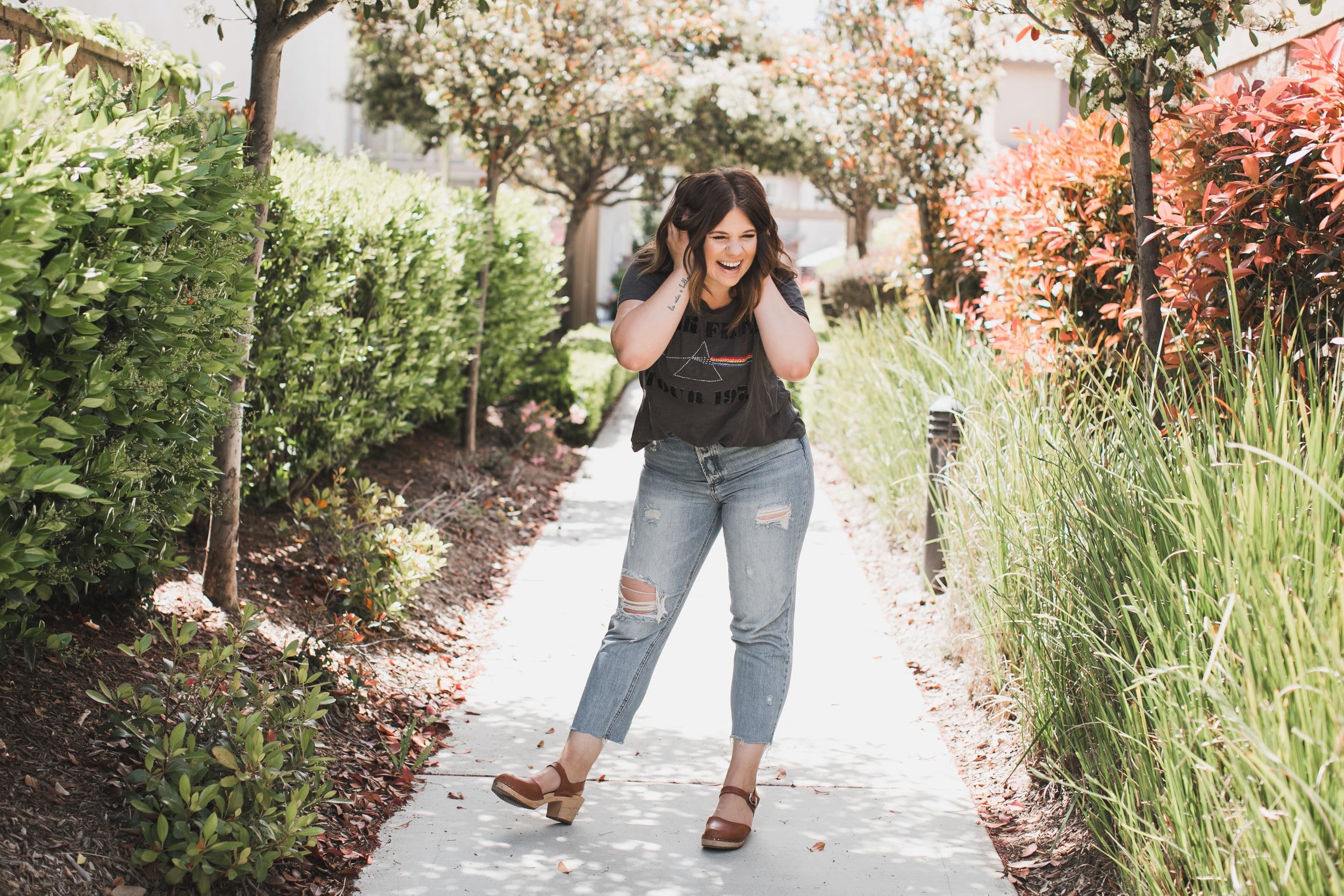

I’m so excited about this episode! I have Chazz Lewis (Mr. Chazz as he is known) joining me and he is basically giving a complete class on child development and kids and their behavior. We’re talking about emotional regulation, transitions, expectations and so much more. Get ready to take crazy notes. Let’s dive in!
In this episode Allie & Mr. Chazz discuss:
Transitions
Breaking generational cycles
Redirection
Regulating yourself when triggered
Mentioned in this Episode:
Courses (Use the code PURPOSESHOW for 10% off!)
The Purpose Show Facebook Community
Mr. Chazz’s Leadership, Parenting and Teaching Podcast


I am freaking out!! Declutter Like A Mother (my BOOK!) is officially available for pre-order!


Mom life. We’re surrounded by the message that it’s the tired life. The no-time-for-myself life. The hard life. We’re supposed to get through it. Survive. Cling on by the last little thread. And at the same time, Carpe Diem—enjoy every moment because it’s going to go by so fast. The typical mom culture that sends us all kinds of mixed, typically negative messages. We shouldn’t take care of ourselves; it’s selfish. The more ragged you run yourself, the bigger your badge of honor. But also, ditch your mom bod and work out. Don’t yell. Make more money. Show up. Be better, but not at the expense of time with your kids. I am putting a hard stop to all of this. While being a mom, running a business, and whatever else you might have going on is hard, it is a lot and there’s lots of giving of yourself, the idea that motherhood means living a joyless, nonstop-hustle-with-zero-balance kind of life, where you give and give and give and never take, needs to stop.
I’m on a mission to help you stop counting down the minutes till bedtime (at least most days). Stop the mom guilt and shame game. Stop cleaning up after your kids’ childhood and start being present for it. I want to help you thrive in work, home and life. I believe in John 10:10 that we are called to living an abundant life and I know moms are not excluded from that promise. Join me in conversations about simplicity, some business and life hacks, spirituality and lots of other good stuff that leads to a life of less for the sake of enjoying more in your motherhood. I’m Allie Casazza and this is The Purpose Show.
Hi, friends! Welcome to The Purpose Show podcast. I am legit smiling ear to ear because my guest today is someone that I have been following for months and been dying to talk to. And it finally happened!
I was so eager for you guys to hear this episode. It wasn’t supposed to come out for months because I’ve been batching my episodes in preparation for my book launch, but I made sure that it got bumped up. This is so good. You have got to soak this all up.
Get ready to take crazy notes. I am not kidding. This episode is like a complete class on child development and your kids and their behavior. It is so good!
We are talking about emotional regulation, both for your kids and for yourself. We’re talking about transitions. We’re talking about raising kids and the hard parts of that—behavioral issues, miscommunication, expectations, parenting. All of it.
If you are unfamiliar with Mr. Chazz, as he has known, you need to familiarize yourself like yesterday. He is probably one of my top three favorite humans to follow on Instagram. He’s just Mr. Chazz.
His mission in life is to enjoy the process of becoming the best version of himself and helping others, specifically parents, do the same. He wants to help adults see, guide and trust children, which I think is so beautiful. He’s an educational specialist who teaches teachers to teach. He also helps parents become better versions of themselves and parent better.
He has an amazing following across social platforms, including TikTok, Instagram, and Facebook. He’s really just brilliant. He does one-on-one coaching too, and I asked him about that because I knew you guys would want to eat that up. I think Brian and I may even book some time with him, especially post adoption.
I am so excited for this. Please soak up this episode. And again, I’m not kidding, you’re going to want to take crazy notes. I’m just going to shut up now so you can listen because it’s so freaking good.
ALLIE: Mr. Chazz, thank you so much for being here with me! I’m so excited.
CHAZZ: Thanks for having me. I’m excited for the conversation and ready to get started.
ALLIE: We are just going to jump right in. Like I said before we hit record, I polled my audience about what they wanted to talk to you about and it was overwhelming. There was so much. One of the biggest things was transitions.
Let’s start with just jumping right into transitions in general. Can you explain a little bit about what is hard about that for kids and what the common problems are? And then I have a couple of questions.
CHAZZ: Yeah! Transitions. This is something that I talk about a lot when I do one-on-one coaching with parents. It is probably one of the most discussed, most frequently brought up topics. Transition, transition, transition.
Why are transitions so hard for children? Really transitions are hard for people in general. For adults too. It is the whole thing of changing from doing one thing to doing another thing. The very basic definition of transitions is going from one thing to another thing.
Before I even get into the practical steps, I like to put this in perspective for the adults. I’m going to use something that most people, if you’re living on earth, could probably relate to. It’s the transition from normal life to pandemic life where there are all these new restrictions and all these new rules.
That was a really hard transition for a lot of people for a lot of different reasons. One, it was really difficult because we were so used to our routines and the security and safety that it gave us. Even if you weren’t concerned about your job, doing your job differently was a big reason for stress, anxiety, and a lot of resistance. That’s something that we can all empathize with.
Think about wearing masks and the transition from being able to go into a public place and not having to wear a mask to actually wearing a mask. One thing I’d like to highlight there is that there were people who said, “Yes, I’m all about this transition. I want to wear the mask.”
But even still, because it was something new, something different, and it wasn’t the routine yet, it was hard. We had to build that routine and get used to actually following through, even though we were all on board with the transition and change.
And people who resisted the transition and change, that came from a place of distrust. Really distrust in a relationship—distrust of the government, distrust of certain people or parties or whatever.
Because that relationship and that distrust is there people may have felt like, “Ah, they’re just making up all these rules to control us. They’re not really looking out for me. I’m not gonna follow your rules. This is how I’m going to rebel.”
A lot of times children can feel that way too. Especially when we’re constantly saying, “No! Stop. Don’t do that. Don’t do that. Stop this. Stop that.”
And sometimes as adults we are really controlling over children. And they feel that and it makes it even harder for them to really move with us in the transitions. And that makes it harder for us to communicate with them.
With all that being said, some general things about transitions that are important are: 1. Consistency. 2. How we communicate the expectations and when the transition is going to happen. And then giving them time to process. Because a lot of times we don’t do that.
We only think about our adult agenda and the things that we have to do because they are so important. We’re like, “Stop what you’re doing. We have to go. It’s dinnertime.”
We’re only focused on our own agenda. So sometimes we don’t even give children adequate time to really process. Or we don’t really think about trying to help them be successful in this transition that is hard for them.
The relationship and overall emotional climate is important with transitions as well.
That’s the general things I would say about transitions. You’re more than welcome to ask more specific questions to help lead me into specifics because I have a lot to say on the topic.
ALLIE: There are all different types of transitions and different types of reactions from the kids. And it’s a lot.
What about day-to-day transitions? Transitions that happen every day and there’s still an issue? There’s still a child who says, “Oh, but I didn’t want to do that yet.”
I have a child who’s 10 and he seems to have his own agenda in his mind and has decided this is the way it’s going to go without communicating anything. But I also didn’t communicate anything because it’s the way it always goes. And when it’s not his way and I say, “No, actually we’re going to go for our nightly walk.” He says, “But I don’t want to do that right now!’”
It throws a wrench in his whole day and then his reaction throws a wrench in our whole day. So, what about when there is a routine, but there’s still an issue? Where is that coming from? And how do we actually sit with our kids in the difficulty of the transitions and what do we actually do for them?
CHAZZ: Yeah. Those are all really good questions.
I think it’s important for us to be aware and take the perspective that sometimes we as adults have the routine of going to work every day. It’s good that we know when it’s time for us to go to work and it’s happening Monday through Friday (or whatever that schedule is), and that helps us stay on track and know what’s next.
But there are some days where we’re really not going to feel like going to work, right? And maybe it has something to do with something that happened the night before. There are likely other variables. Not all the time, though. Sometimes we just don’t feel like doing it today.
Instead of going into a place of, “I’m the adult and you need to obey what I say because I’m bigger than you. I’m an adult. I’ve been here for longer than you. You need to listen to what I say.” When we do that we’re inviting defiance and that creates a disruption in the relationship.
Instead of focusing so much on obedience, focus more on cooperation and understanding. Maybe there is a reason that the 10-year-old doesn’t want to go out on a nightly walk. If it’s something where you’re consistently like, “Hey, this is something that we’re doing as a family. This is something that we all agreed upon that we’re going to do. I’m noticing you are having a hard time.” Prepping him in those 3 minutes, 10 minutes, 5 minutes ahead of time can help them process.
Maybe they are playing a game, playing Legos, or pretend playing. To them, it is really important. It is just as important to them as that walk or whether or not you’re going to have a job the next day is to you. It’s really important to them.
Really being sensitive and aware and saying, “Look, I know you’re doing your game. It’s almost time for our family walk in about 15 minutes.” I always suggest a visual timer, especially for younger children, because time is such an abstract concept for children.
And honestly, we don’t make it any better when a lot of the time we’ll say, “All right, in five minutes we’re going to do this.” And then it’s 5 minutes, sometimes 10 minutes. sometimes it’s an hour. Sometimes it doesn’t come. Sometimes it only comes when they remind us.
Time can be really hard for young children, specifically, but also for children with ADHD. It’s a harder concept to grasp for especially young children, so a way to help and to communicate that transition of how much time they actually have, as opposed to this ambiguous five minutes that we always give is using a visual timer that literally shows you how much time.
There are a lot of different visual timers, but my favorite one is the one that’s a circle and there’s color that shows how much time the child actually has and as time passes the color slowly goes away. Even if they’re playing a game they can quickly check and see, “Ah, man, there’s barely any red left. I need to finish up this game.” And they have a little bit more time to process that.
Now in what I was talking about there in terms of giving them time to plan, to process, and acknowledging what they’re doing which is really important to them too, all those things are things to help them be more successful in the transition. And sure, especially for younger kids, making it fun and singing a transition song, incorporating that in the routine can help ease the friction of the transition.
Also letting them know what’s going to happen after. For example you could say, “I know you’re playing your game. When you’re done, we’re going to go on our walk.”
Maybe there’s something about the walk that your 10-year-old really enjoys, right? Maybe it’s getting to throw rocks in the lake. Maybe it’s seeing if something has changed from the last time you went (Oh, I wonder if they built that construction site that we walked past. I wonder if they built it up? What do you think?).
Different children have different parts and different interests. Point those things out. You can even do that in the five or ten minute warnings ahead of time, so as they are processing and wrapping up whatever they’re doing it’s not so much a feeling of, “Oh, I have to stop doing this really fun thing that I really enjoy and really love.”
It’s more a feeling of, “Oh, I get to do this thing that is coming up. I wonder if the roof has been made at the construction site. I wonder how far I can throw the rock in the lake.” Maybe you’re driving and there’s certain buildings that your child really likes to see and point out.
Maybe the transition is that hard transition when you’re coming off the playground and coming inside and having lunch. You could talk about like, “Hmm, I wonder if the pizza is still going to be hot.” Or “I wonder how many pepperonis we’re going to have.”
It’s a combination of sparking their curiosity about something that’s going to happen next and helping them envision and visualize what that next thing is going to look like. All of this is really to help them be more successful in the transition process.
If you do all the things that you can think of to help them through the transition, help them process, help them see the other side. And you’re really respecting and acknowledging the thing that they deem to be important. That’s not to say that they are not still going to have a hard time with that transition. Change is still hard. Transitions are still hard for people in general.
Maybe you’re turning off screen time, right? You’re turning off the screen and maybe it’s not even like, “We’re going to go do something!” But like, “Hey, screen time is over.”
And after you’ve really helped to support them, being confident in knowing that you’re communicating as much as can in all these different ways about what’s going to happen, what it’s going to look like, what you can do after is say, “It’s time for this screen to go off. It’s time for game time to be over (or Lego time or whatever it is). You might be upset about that. And that’s okay. It is really frustrating when you really want to continue playing and you have to stop. I get that. I get that that’s frustrating. That’s a real feeling.”
As opposed to what we have a tendency to do which is dismiss the feelings and say, “You’re fine. You’re going to play the game tomorrow. We do this every day. You need to just get over it.” Which sometimes is our response, and maybe some of it’s coming from our frustration. Be there for them and allow them to have their emotions.
Allie, we’re going to do a quick little thing together to illustrate it more deeply. And for those out there listening you’re going to have a different thing than Allie, or maybe the same thing as Allie, but think about what your thing is.
Allie, what’s the one that you love to do that is just by yourself that you enjoy? No kids. Full freedom. What’s something that you love to do?
ALLIE: Taking my laptop to a coffee shop and sitting for a couple of hours.
CHAZZ: And what do you do during those couple of hours?
ALLIE: I listen to audio books. Journal on my laptop. Get some work done in peace. Maybe outline some podcast episodes. Just a moment to focus without interruption. That’s what I love to do.
If it’s not good for your example, the other thing that came up is Pilates. I love doing Pilates without being poked and interrupted.
CHAZZ: I can use either one of those examples. I just wanted to make sure it was something that you really enjoy doing.
ALLIE: Yeah. I’m always looking for time to do those things.
CHAZZ: Okay. Yeah. So I might even use both.
I’ll use Pilates because I think that more people probably will do things like Pilates for them to recover joy, as opposed to wanting peace and time to work, which I hope you’re having both time to work and time for Pilates.
So let’s say you have this Pilates class planned. It’s at 2 o’clock and you probably have some Pilates gear you’d like to put on. And do you go to a studio or do you do it at home?
ALLIE: I usually do it at home.
CHAZZ: Okay. So do you have a space, a mat and everything? You get all your gear together and you get your mat and everything and you’re like, “Ooh, I just need this hour. I’m going to have this hour with Pilates and I’m going to feel so much better after it.”
You get into your first position, you’re doing your first thing, and you’re really getting in the zone. Then all of a sudden someone comes in and says, “Hey, stop what you’re doing. Stop the Pilates and do this thing that I need you to do. This thing that is important to me but not really important to you.”
Like I indicated in the beginning, you’re going to have feelings of annoyance, frustration, and anger. Those are probably going to be your initial feelings. Seeing as you’re an adult who seems to be good at emotionally regulating themselves, you will maybe breathe and you’ll say, “You know what? The Pilates can wait. There’s probably a really good reason why this person needs me and the Pilates will be here. It’s not the end of the world. I can take the perspective of this other person and I can help this person out. I can come back to Pilates later.”
Now, because you’re older than 25 and your prefrontal cortex is fully developed, you have more of a capacity to do that. The prefrontal cortex is the logical part of your brain that does all the perspective taking to regulate and to see someone else’s perspective and all that stuff.
Now children, especially children 5 and younger, don’t necessarily have those skills because the prefrontal cortex isn’t fully developed until 25/26 years old. And so a lot of times, especially younger children, you’ll see these big emotional reactions because they have that same initial feeling that you had when you felt frustration but they don’t have the brakes, the perspective-taking point-of-view that, “It will be here. This isn’t the end of the world. I can do Legos tomorrow. I can play this. I will have another opportunity to play Fortnight.”
That’s a skill that needs to be built. And that skill is not built by us as the adults dismissing their point-of-view and their perspective and saying, “Well, you just need to listen to me. Because I said so. It doesn’t matter what you feel or what you’re doing right now. I said that you need to do this and nothing else matters.”
As parents, as teachers, as adults, as primary caregivers in a child’s life, we are teaching them how to be in a relationship. We are teaching them about relationships. So if we take the approach of “What I say matters because I have more power in this situation. I have this role, this title as parent and what you say doesn’t matter. I’m not going to take any effort or time to see the world from your point-of-view.” Then it shouldn’t surprise us that when they get into positions of power, or if they have a younger sibling, that they respond the same way.
And maybe it’s not just siblings, maybe it’s other people out in the community that have less power. Maybe they get a manager position. Or maybe not even in the work context but just in a people context where there’s a person that has less power than them. They may be inclined to treat that person the same way that they were treated.
As opposed to us taking perspective and practicing that perspective-taking with them and helping them see the perspective of other people so that when they get in positions of power—whether it’s being an older brother or a manager or a leader in a workplace or it’s just a different status in society or privilege that they have—they will be well-practiced at empathy and perspective-taking and working through cooperation. As opposed to imposing power and will upon things.
Now that’s not to say that sometimes the appointment is at 2 o’clock and they gotta make it to the appointment. Sometimes it does take you saying, “Look, I know you’re really upset. I know you feel this way. I hear you. We still have to go.” And maybe you will have to take that screaming 3-year-old and pick them up and move them along. That may happen.
But imposing our power and our will by physical force, punishment, shame, judgment and all those other things that we do to try to coerce children to obey what we’re saying shouldn’t be our first go-to.
ALLIE: Yeah. So often it’s our knee-jerk reaction to just control and use our adultness and our force.
I love everything that you’ve been saying because it really puts the responsibility on us as adults, which is where it should be. But in reality, when we’re going through the day we often put the responsibility to make things happen on the kids reacting positively. Instead of us planning further ahead, setting that timer, remembering to remind them, and making maybe a few extra minutes to sit on the curb outside of the car with them when they’re freaking out and just need a minute. It’s really putting the responsibility right where it belongs.
CHAZZ: Yeah, and it’s tough. I’m not here to say that it’s easy at all. It is tough. It’s really tough to do this.
And it’s especially tough because a lot of us didn’t have those examples growing up. We were treated with the same, “I’m going to impose my power: ‘Because I said so.’ I’m going to impose my power and will on you because I’m the adult and I can, and you’re the child and you need to listen.” That was programmed into most of us from a very young age.
Now we’re in these powerful positions and we want to do that same thing. We also don’t necessarily have the skills or tools to figure out how to do something different. So, when we get overwhelmed and we feel like we’ve tried everything, maybe we don’t know everything or have all the tools.
Classic example: “I told them to stop coloring on the wall. I told them, ‘No, no, no! Stop, stop, stop! Don’t don’t don’t!’ and they still kept doing it.”
You may not know that 2-year-olds need to color, paint and draw with their whole body. That is a developmental need at 2. And so while you’re saying, “No, no, no, no. Stop. Don’t color on the wall,” their body is telling them to do things to meet their needs.
Sometimes for older children it’s, “You need to sit down and listen to this long lecture.” Maybe you do virtual learning and they have to choose between listening to their body and listening to the adult. And it’s not healthy for them to listen to the adult, really. In all honesty, it’s not healthy for children to ignore what their body is telling them to do.
So what do you do instead? You give them an outlet. A way to do that thing that they’re trying to do to meet that need in a more appropriate way. For the coloring on the wall it’s the easel. You say, “I see you want to color. You want to use those big strokes. You can do that on the easel.”
If you don’t have the money to buy an easel, get some cardboard. Everyone’s got Amazon boxes somewhere. If you don’t, your neighbor does. On recycle day you can go and get boxes and bring them in your home and you can put them on the ground and allow them to make those big strokes.
You may not know that that’s a developmental need. But something that I will say that may help a lot of people out there is that children, especially young children, know intuitively everything they need to do for their bodies and their brains to grow. But they may not necessarily know how, where, and the most appropriate way to do it.
Climbing. That’s another thing. “My kids are climbing all over. They are climbing on the oven. They are climbing on the glass table. I tell them to stop and they won’t stop.”
That’s a developmental need. A 2-year-old needs to climb. It’s important for their development. Not only working on gross motor, those large muscles, but it’s also starting to work on fine motor skills—finger muscles—so they are able to do things later like hold a writing utensil with control so they can write their name.
All these things are important for their development, but we still don’t want them climbing on the oven or the glass table. So what do we do? We redirect them. We show them and we talk to them about the appropriate place for them to meet that developmental need.
We say, “I see you want to climb. I see you have a lot of energy in your body and you really want to climb. Climb on the couch or climb up the stairs.” (or any other place that you deem safe enough for them to climb). And a little bit of risk is good for their development too. Risky play helps build confidence and a lot of other things too.
It’s not about saying, “No. Stop. Stop climbing. Don’t color.” It’s about where and how they’re doing that. That’s where we come in to guide children and to teach them how to meet their needs.
Even with disrespect. Teach them how to express these big feelings and opinions that they have in a way that’s more prosocial and more appropriate. The way that’s going to be more effective to meet their own goals.
One more thing on the “No. Stop. Don’t” is that we have a tendency as adults to say, “No! Stop! Don’t! Don’t climb on that. Stop doing that.”
We have a tendency to overuse “No! Stop! Don’t!” I’m not saying you never say “No! Stop! Don’t!” There are definitely times where it’s appropriate to say, “No! Stop! Don’t!” But we very much tend to overuse those phrases.
And it’s really counterproductive because what we focus on, they’re going to focus on. So if we say, “No! Don’t color on the wall.” All they are hearing and thinking about is coloring on the wall and we haven’t given them something else to focus on. You haven’t given them something else that they can use where they can meet that very real need that they’re trying to express and meet.
Instead, say, “You can color it here. You can go climb on the couch or the stairs.” If they are running around the house, you can tell them to walk.
Now the level 2 of that is you want the thing you’re trying to do to meet the need that they’re trying to express, right? They’re running around the house and you say, “Sit down on the couch or walk.” Yes. That’s better than “Don’t run.”
And in some instances, like in a restaurant that might be more appropriate. But we also have to acknowledge that the child likely still has that strong need for physical activity. Find another way that he or she can meet their need for physical activity that’s appropriate for the situation.
Can you have a dance party? Can they climb on the couch? Can they go up and down the stairs? Can you make an obstacle course?
Can you put that mattress or beanbag out and they can just jump face first on it because they love to do that kind of stuff? Can they go to the playroom? Can you go outside? All these different things that they can do to meet their needs.
It’s really our role as adults to help them identify what they’re feeling, to look within, and then to be able to express that in appropriate ways, in ways that are effective, prosocial, don’t harm anyone else, don’t harm themselves. It’s a really big challenge.
The very last thing I want to say on this is, don’t be a perfectionist, be an improvenist. The goal isn’t to be perfect every day; the goal is to improve a little every day.
ALLIE: That’s so good. As you’re talking about all of this, I’m thinking about those of us who were not raised like this, which is pretty much everyone listening most likely, unfortunately.
I feel like when our kids stress us out that we often don’t have the emotional regulation skills that we’re trying to teach the kids. How can we adults be better about regulating our own emotions?
Specifically, like that feeling that your kids sometimes give you, like when you stub your toe and there’s nothing that’s going to help you other than yelling the F-word and no one talking to you for a minute. It’s that level of anger and annoyance. Your kids bring that out in you sometimes. They trigger you.
How can we get better at regulating ourselves when even we don’t often have those skills that we’re trying to teach them? I feel like you’re teaching them at the same time as you’re trying to learn it yourself. How can we get better at that?
CHAZZ: I think you’re right.
One, it’s important for us to do the work ahead of time to identify what situations typically trigger us. Is it when they respond back to us in a way that we don’t prefer? Is it when we are repeating ourselves and we’re asking them to do something and it’s still not being done? Is it when they hurt their sibling?
It’s important for us to know our triggers so that when we go into the situation we’re a little bit more stable and we’re also a little bit more prepared to do those regulation techniques of taking a step back and breathing.
A lot of times our unconscious, our programming, comes up and it’s our unconscious saying “Arrgh!” at our children. We want to bring that as much as we can to the subconscious by thinking about it, maybe even journaling about it, practicing how your body feels once you are triggered so that you can recognize when your body’s going in that state.
Do you scrunch up your eyebrows? Do you scrunch your nose? Do you grit your teeth? Ball up your fists?
How do your ears and your face feel? Do they get hot? How’s your body feeling? Do you tense up?
Practice that when you’re alone. Practice what that feels like so you can familiarize yourself with that feeling when you get in that situation. Then in the moment when you stub your toe and you think, “Man this is going to hurt. I’m just going to wait for this feeling, for the pain to set in. I’m going to breathe. I’m going to say the F-word, and I’m going to regulate. I’m going to let it go and then I’ll be okay.”
I think we all know this stubbed toe isn’t going to last forever, but I’m experiencing this feeling right now. I’m experiencing this being triggered right now. I just need a second to regulate.
Maybe you need a minute. Maybe you need five minutes. Breathe. Once you feel like you’re in a more regulated state then you’re able to respond as opposed to react emotionally.
And when you’re in this triggered reaction, unconscious, emotional state, you’re not going to be thinking of necessarily the best ways to respond, unless you’re really practiced at it. Even in those moments, even if you’re really practiced and you kind of have the script of what to say, there’s probably going to be a wrench or something that’s going to happen in the moment that is going to throw you off.
I would suggest to even the most practiced people to regulate yourself. Become aware of what you’re feeling in your body, because it’s likely that that’s going to be expressed, even if it’s not with your words but with your body language, tone of voice, your facial expression.
These things that we do communicate to the emotional brain. When you are reacting or responding to your child, they’re looking at those things, even if they’re not super consciously studying it. Those are things that they are registering and that they’re interpreting with their emotional brain.
ALLIE: It’s like you can pick up on the energy of someone. Even if their words are not matching it, you can still just tell, especially kids.
CHAZZ: Children do very much feel your energy and that’s going to impact that interaction that you have. And it’s not helpful. If you’re in dysregulation, you’re communicating that and you’re spreading it even more to your child who is likely already dysregulated. That then creates more feelings in your child, which might create a reaction that might trigger you even more.
Then it’s this cycle that’s escalating, escalating, and escalating. If we would just have taken a step back earlier and just regulated ourselves, then we could have really nipped that escalation in the bud and could have had a completely different interaction where our child was actually really able to hear us more than the yelling, our dysregulation, and our emotional reaction at them.
ALLIE: Speaking from my own experience, I also think if there’s something that’s constantly triggering you and you’re constantly finding that. Or you were raised in a way that didn’t help you have this emotion regulating skill. We need to support ourselves in that with therapy. Or do energy work, meditate more, whatever it is.
But I feel like if that’s a pattern in me, which it was, it’s my responsibility to do something about it. And not even for my kids but for myself. And to honor what I’ve been through, what’s coming up, and then deal with it.
Not just like, “Oh, I’ve just got to get a handle on this. I lost it on the kids again.” But really, as people, it’s our responsibility to do the inner work.
CHAZZ: Yeah, 100%. Therapy is something that I would suggest for really anyone. I think everyone could benefit from therapy. Especially if you’re reflecting that your reaction did not match up with what was actually happening. That’s a sign that maybe therapy might be beneficial.
Another thing that I would suggest, with the breathing and emotional regulation and doing that perspective-taking like I talked about earlier, is mantras can really be helpful for that because it’s something that you can repeat to yourself even when you’re dysregulated.
One of my favorite ones is “children aren’t giving you a hard time; they are having a hard time.” And that really does change the perspective from, “They are just trying to get on my nerves. They’re just trying to push my buttons or trying to make me mad,” to “There’s something about this moment that is tough for my child and they’re responding in this emotional way.”
Or they’re having a hard time with this transition. Or something at school. Or they’re having a hard time with not getting the connection that they are wanting, so maybe they’re acting out.
Acting out is short for acting out of character, right? So knowing that this is not who my child is. This dysregulation, this emotional reaction is not who my child is. Just like your emotional reaction as a parent is not who you are and that does not define you.
It is the emotions that we are not fully understanding that are pulling us out of character. The perspective and the lack of understanding that we have about the situation that is pulling us out of character and causing us to act out. “My child is not giving me a hard time; they are having a hard time” can be the shift that can put you into a problem-solving state.
To where you’re like, “Hmm…behavior is communication, so what can my child potentially be communicating here? Is it something about the day? Is there something about this moment? Has this been something that’s difficult for him or her over a period of time, something that’s recurring?”
It does get us in the problem-solving state to work through whatever it is. To maybe respond with curiosity as opposed to judgement and shame. That’s what I would add.
The physical regulation of breathing and taking a little bit of time, but also saying some mantras to yourself. Because patience doesn’t really come from resisting anger. That’s not really patience. Patience comes from understanding. It comes from comprehension.
That’s part of the reason why we get frustrated as adults. It’s part of the reason why children get frustrated as children. And so, that’s what I would add to that: self-regulation. Self-regulate as you’re learning.
Give yourself some different self-talk, a new story. You’re not a bad parent. You’re not a bad mom. Just like they aren’t bad children. You’re just having a hard time right now.
ALLIE: Oh my gosh, this is a repeat episode to just go listen to over and over again. Thank you so much! This is so valuable. You just don’t hold back. You give so much. So helpful. Thank you.
I know that you do one-on-one coaching. You have an incredible Instagram. Is that where you’d want to send people? How can they work with you? What are the next steps if people are thinking, “I need this guy to help me.”?
CHAZZ: Yes. I work with a variety of parents, but I definitely work with a lot of parents breaking the generational cycles that we talked about.
For one-on-one coaching with me, you can get access at a couple of different tier levels. Depending on what you’re looking for, you can pick the one that fits you and what your needs are. You can get access to that at www.patrion.com/MrChazz. That’s how you can work with me one-on-one. It’s a one hour zoom call.
I also put out free content all the time on TikTok, Instagram, Facebook, even LinkedIn, here and there. I’m pretty much Mr. Chazz everywhere. The variation might look a little different. On Instagram it’s MrChazz (one word). On TikTok, it’s MrChazzMrChazz (combined). On Facebook it’s Mr.Chazz Mr.Chazz (space in-between). But If you type in Mr. Chazz on any of these platforms I should come up.
I also have my own podcast called Mr. Chazz’s Leadership, Parenting and Teaching podcast. It’s really all in the pursuit to help and provide resources to people who are struggling and looking for answers. Who don’t necessarily understand child development, but they have a child. People who don’t necessarily have the model of how to do things differently than how they were raised. How to improve, and learning different strategies.
Through all of those resources I try to immerse you into all these different people, resources, ideas, perspective, strategies, and tools to help you be the parent that you want to be, to help you on your journey. So that’s where you can find me.
ALLIE: So good. Thank you again so much. And we’ll link to everything that you mentioned in show notes as well if anyone’s on the site and wants to just click over. I appreciate you. We need to have you back to talk about discipline.
CHAZZ: Oh, please. Let’s do it. Anytime you’re ready just DM me.
ALLIE: I will. It’s going to be so good. Thank you again so much.
Thanks so much for hanging out with me! In case you didn’t know, there’s actually an exclusive community that’s been created solely for the purpose of continuing discussions around The Purpose Show episodes. It’s designed to get you to actually take action and make the positive changes that we talk about here. I want you to go and be a part of it. To do that, go to alliecasazza.com/facebookgroup.
Thank you so much for tuning in! If you’d like to learn more about me, how I can help you, how you can implement all these things and more into your life to make it simpler, better, and more abundant, head to alliecasazza.com. There are free downloads, online courses, programs, and other resources to help you create the life you really want.
I am always rooting for you, friend! See you next time! I’m Allie Casazza and this is The Purpose Show.
Hey mama! Just a quick note, this post may contain affiliate links.











+ show Comments
- Hide Comments
add a comment